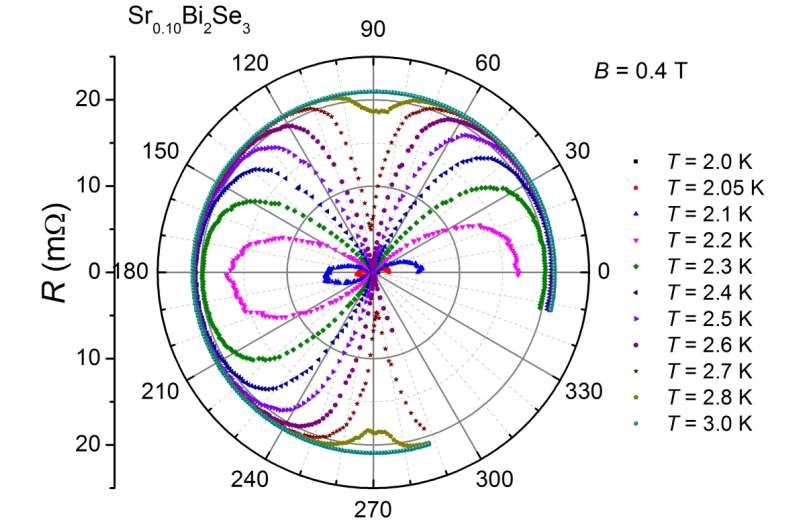Superconductor's strange behaviour results in new laboratory tool

Researchers from the Foundation for Fundamental Research on Matter and the University of Amsterdam (the Netherlands), together with researchers from the Institute for Materials Science in Tsukuba (Japan), have discovered an exceptional new quantum state within a superconducting material. This exceptional quantum state is characterised by a broken rotational symmetry – in other words, if you turn the material in a magnetic field, the superconductivity isn't the same everywhere in the material.
The material in which the new quantum state was discovered is bismuth selenide, or Bi2Se3. This material is a topological isolator. This group of materials exhibits a strange quality: they don't conduct electricity on the inside, but only on their surface. What's more, the researchers are able to make the material even more exceptional – by adding a small amount of strontium to the bismuth-selenide, the material transforms into a superconductor. This means the material can conduct electricity extremely well at low temperatures, because the electrical resistance has completely disappeared.
Electron seeks mate
Superconductivity can be explained by the behaviour of electrons within the material. In a superconductor, certain electrons seek a mate and combine into pairs. These pairs, so-called Cooper pairs, can move through the material without resistance or a loss of energy.
Broken symmetry
The research team placed the material in a magnetic field that suppresses the superconducting properties of the material. Bismuth selenide has a layered crystalline structure, and the magnetic field the researchers used was directed parallel to the plane of these layers. Usually, it makes no difference in which direction the magnetic field points, because the suppression is the same in all directions. However, the researchers discovered that this isn't the case with their exceptional material. When they turned the magnetic field in the plane of the layers, they discovered that the superconductivity was suppressed to a greater and to a lesser extent, depending on the direction in which the field pointed. In other words, the material's rotational symmetry was broken.
Preferred direction
The phenomenon of broken symmetry can only be explained if the electrons in this material form special Cooper pairs, namely spin-triplet pairs, instead of the usual spin-singlet pairs. Such Cooper pairs can adopt a preferred direction within the crystal.
New lab tool
The team, including FOM PhD students Yu Pan en Artem Nikitin, points out that the discovery proves that this exceptional material forms a unique laboratory tool. The superconductor will allow physicists to study the exceptional quantum effects of topological superconductivity.
More information: Rotational symmetry breaking in the topological superconductor SrxBi2Se3 probed by upper critical field experiments, Y. Pan, A.M. Nikitin, G. K. Araizi, Y.K. Huang, Y. Matsushita, T. Naka and A. de Visser, Sci. Rep. 6, 28632 (2016). DOI: 10.1038/srep28632 (2016).
Journal information: Scientific Reports
Provided by Fundamental Research on Matter (FOM)


















